Land Rover Discovery. Manual - part 51

EMISSION CONTROL
7
REPAIR
EVAP CANISTER AND PURGE VALVE - 4.0 V8
Service repair no - 17.15.13
Remove
1. Disconnect battery negative lead.
2. Disconnect multiplug from EVAP purge valve.
3. Release purge valve rubber mounting from
bracket.
4. Release clip and remove hose from EAVP
canister.
5. Loosen bolt.
6. Remove EVAP canister and purge valve
complete.
Refit
7. Reverse removal procedure.